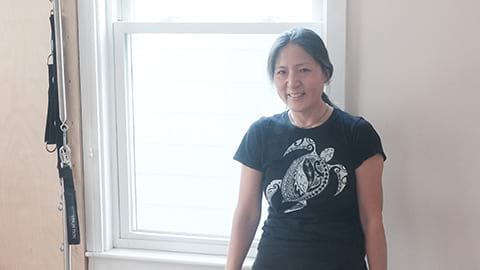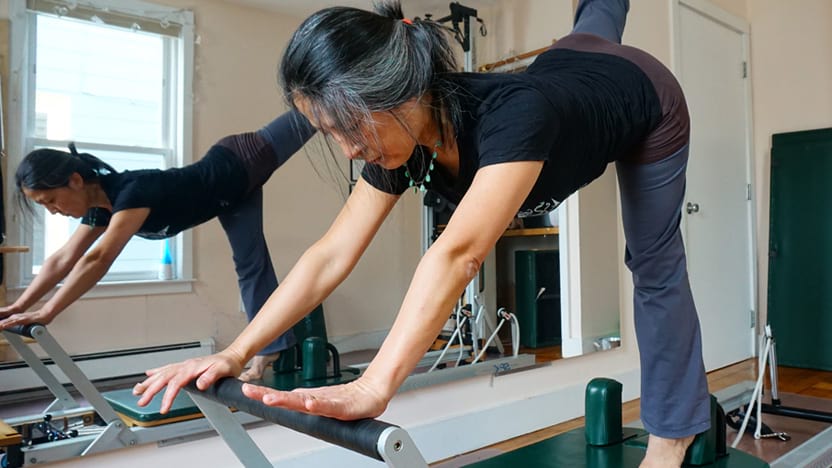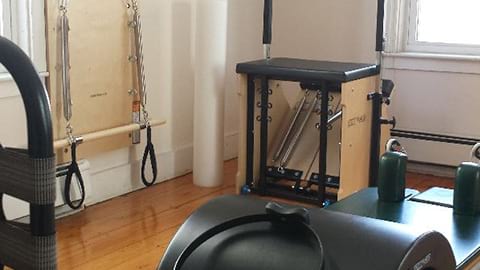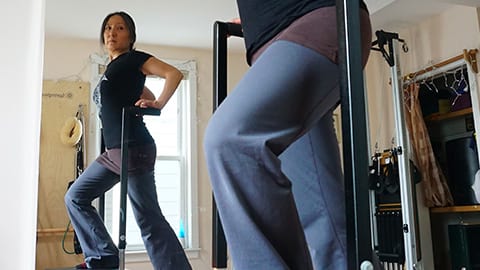Helena Chang
Merrithew® Certifications:
STOTT PILATES® Certified Instructor

“Each client is a puzzle and I’m a detective, looking for clues that others may have missed,” said Helena Chang. The Certified Instructor from Cambridge, Massachusetts, describes herself as a “very detail-oriented person” with a passion for understanding how the body works. She explains the importance of looking at the smaller details when it comes to working with her clients.
Combining massage therapy with Pilates
Helena’s career didn’t begin in the realm of mindful movement. Rather, she started with massage therapy. Focusing on chronic and acute pain relief, she ran her neuromuscular massage therapy (NMT) practice in Cambridge, Mass., for almost 20 years before becoming a STOTT PILATES Certified Instructor in 2008.
“I discovered STOTT PILATES through one of my massage clients, who happened to be in her seventies,” Helena said. “Over the course of just a few weeks, she suddenly grew beautiful upper back muscles and became less kyphotic. Turns out she had started studying at a STOTT PILATES studio in Boston. I had been looking for an adjunct therapy that would help maintain the openness their bodies were achieving in our massage sessions. I tried a session with her teacher and was hooked!”
Helena completed her STOTT PILATES Mat and Reformer Level 1 training at C2 Pilates, the Merrithew® Licensed Training Center in Connecticut and completed the Level 1 exam at Northeast Pilates Education Center, the Merrithew Licensed Training Center in Massachusetts. Helena recruited her massage clients to be practice bodies for student teaching (converting each of them to Pilates clients!) She discovered just how well massage therapy and Pilates complemented each other.

“Postural assessment was a big component of my NMT training, so that felt congruent to the STOTT PILATES work. I use NMT to clear up postural holding patterns that keep a client from achieving a nice neutral stance and STOTT PILATES to get them strong enough to hold pain-free positioning. As a result, decades-long pain cases can sometimes get resolved in a matter of months.
“Before I got involved with STOTT PILATES, I could help clients achieve a more open and relaxed posture with NMT, but usually they’d collapse back into their dysfunctional postural patterns between sessions and return, still symptomatic - on the other hand, too much tension can make it hard for a Pilates client to activate particular muscle groups. We’ve all had new clients with super tight hip flexors who can’t get their lower abs turned on. By treating the feet with massage therapy I can turn off the hip flexors in a matter of minutes during footwork.”
“While I mostly teach Pilates now, another holdover from massage therapy is that I am trained to manually manipulate muscles. I often palpate or tap muscles during a Pilates session, either to assess if the client is recruiting muscles correctly, or to stimulate or intensify muscle activation. Sometimes, I’ll hold an overactive muscle in a stretch so its antagonist muscle can contract. I don’t think I’d feel comfortable doing that if I wasn’t a massage therapist first.”

Empowering clients to feel better
“Everyone has the desire to feel better and function better, and they want to understand the physical connections that can make it happen,” Helena said. “I feel my role as a movement teacher is to educate people in the optimal use of their own body.
“STOTT PILATES teacher training helped me along that path because it emphasizes programming and modifications based on ability level (the why) rather than just choreography (the how),” she said. “Clients often ask me why I choose particular exercises for them. I think it’s reassuring to them that I always have a ready answer. It builds trust.”
Helena added that she often works with clients who have exhausted other options to feel better. Many are resigned to enduring chronic pain, living in fear of unexplained physical symptoms, or have given up activities that were meaningful to them.
“In these cases, I know that the usual approaches didn’t work, so I look for clues that other practitioners missed. I had one client who had panic attacks that turned out to be physically triggered by her super-tight pectoral muscles. Another client was able to achieve diaphragmatic breathing (and engaging her abdominal wall) for the first time, while stretching the very bottom of her right iliopsoas by keeping the lesser trochanter tractioned away from her pelvis.
“I’ve had a couple of sciatica cases that improved only after we stretched and strengthened the latissimus dorsi. These solutions actually make a lot of sense if you think about it, but they took trial and error to evolve. In the meantime, these clients led limited lives, or suffered, or were labeled psychosomatic by their doctors. I get a lot of satisfaction in teaching someone a stretch or exercise that immediately eradicates a long-standing problem. It’s empowering for both of us!”

Play to your strengths
Today, Helena is in-demand as a Pilates instructor in Cambridge, but it wasn’t always that way. She felt pressure to conform to a certain style of teaching when she started out at a gym because many of the clients wanted “hard and fast classes to achieve a certain physique”. But Helena found her calling when she began teaching matwork classes at the Harvard University Wellness Center.
“Those classes were full of office workers dealing with back pain,” she explained. “We mostly did STOTT PILATES Matwork, but I also taught stretches that they could do at their desks as well as self-massage and postural awareness. I loved teaching that class. Pretty soon, my class would fill-up within 10 minutes of becoming available online. I realized that I am better at working with people who are interested in functioning more efficiently, rather than just looking better.”
Helena concluded that it’s important for instructors to recognize their teaching strengths, refine them and stick to them.
“I am really observant and meticulous. I have been told throughout my career that I teach too slowly,” she said. “But, observation is a huge element of my teaching, and I have been super busy ever since I embraced my own style and priorities.”
A big priority is continuing education – though she mostly teaches Pilates, Helena is also certified to teach yoga, a licensed massage therapist and is currently a Gyrotonics apprentice teacher. “Almost every day, a client shows me where I could be more knowledgeable in a session. Thanks goodness for continuing education!”
You can find more information about Helena on her website.